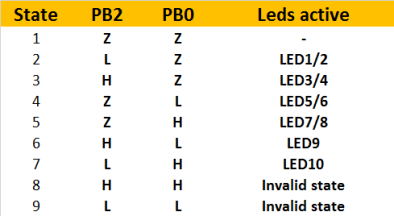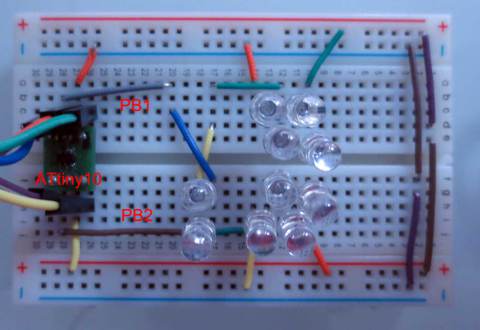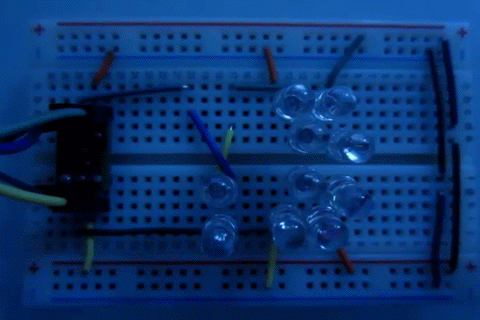Recently impulsive, I bought a very low cost electronic tweezers kit. The assembly process is still quite classical. The design style of this circuit is still in the 70s: a CD4017, a NE555, a pair of transistors. Of course, I started thinking about how to achieve it in the most efficient way. Of course, this means that a microcontroller is needed; and we have to achieve the goal of making our resources as low as possible. So can you implement ATTIny10 with 3 I/O ports? The pattern of the dice contains 7 LEDs, but you may soon find that six of the LEDs are in pairs, so we have 3 pairs of LEDs plus an additional LED to control. This requires four I/O ports - but it's still too much! To reduce the number of I/O ports needed, one obvious use is Charliplexing. You can find a lot of circuit diagrams on the Internet for Charlie multiplexing technology. In simple terms, Charlie multiplexing technology allows n2-n LEDs to be controlled using n I/O ports. So when we use Charlie multiplexing, we need three I/O ports. But for the ATTIny10 we use it is still too much, because we also need an extra I / O port to "shake the dice". Charlie multiplexing uses the tristate nature of the microcontroller I/O pins. There are only two I/O ports activated at the same time - one high and one low - while the other pins are high impedance. Only LEDs that are directly connected to the correct polarity and activated pins can illuminate. LEDs on paths that are not directly connected to the pins—such as two series-connected LEDs connected to the active pins—these LEDs do not illuminate because of the nonlinear current-voltage characteristics of the diode. of. Now, you may be wondering what happens when only one I/O port (not two) is activated. Nothing happens in the Charlie reuse technology solution, but we can take advantage of this. The above circuit shows how to connect LEDs in different ways. In addition to the anti-parallel pairs between the two I/O pins, as a usage habit of Charging Multiplexing, the LEDs need to be connected to VCC (5V) and GND. The sum of the forward voltages of the four LEDs in series (LED1-4 and LED5-8) exceeds 5V, so when PB0 and PB2 are in the high impedance (Z) state, these lamps will not emit light. When one of PB0 and PB2 is in a high or low state and the other pin is in a high impedance state, then a pair of LEDs will illuminate. When PB0 is high and PB2 is low or vice versa, LED9 or LED10 will be in parallel with a pair of LEDs. At this time, most of the current will flow through a single LED, so only LED9 or LED10 will emit light. The above table is a possible encoding. see it? Two pins can control six parts of the LED! This is exactly what we need and the task is done. But one thing to note: the brightness of a single LED is different from the two LEDs in series. This may require corrections in the Charging Multiplexing technique. But in fact, because the human eye is not particularly sensitive to the difference in brightness, the difference between the two can only be said to be barely visible. Simply test it (LEDs are not arranged like dice). It seems that our new multi-multiplex technology works well. Note that this circuit requires the internal impedance of the AVR I/O interface. This works, but it should be avoided in a "real" design. We can talk about this new solution as "Charlieplex Plus". Analysis shows that relying on such a technology, an I/O port can control two LEDs more than ordinary Charlie multiplexing technology. That is to say, the number of LEDs that can be controlled by n I/O ports is 2n+n2-n = n2+n. The details are as shown in the table above. Should you adopt this approach in your design? I am afraid it should not, because the flaws and limitations of this approach are even more than the existing Charlie reuse. But this is very interesting! So back to the beginning, how many I/O ports do you need to control the electronic dice? The answer is 2.
SMT Other Parts
Smt Spare Part
Smt Printer Spare Parts
Printer Spare Parts
Dek Printer Spare Parts
Dek Smt Spare Parts
Smt Machine Dek Printer Spare Parts
Original Smt Gas Spring
Gas Spring
Smt Gas Spring
Smt Fuji Gas Spring
Smt Spline
Smt Shaft
Original Smt Spline
Original Smt Shaft
Smt Parts Power Supply
Smt Feeder Power Supply
Smt Power Supply
Power Supply
Smt Fuji Pulley
Original Smt Pulley
Smt Pulley
Smt Conveyor Belt Pulley
Smt Motors
Smt Juki Motors
Original Smt Servo Motor
Original Smt Motors
Holder For Smt Type
Smt Battery Holder
Smt Holder
Battery Holder
Filter For Smt Machine
High Quality Smt Filter
Smt Filter
Smt Machine Filter
Smt Tape Feeder Parts
Feeder Parts For Smt Machine
Smt Machine Spare Parts
Original Smt Feeder
Original Smt Cable
Smt Machine Cable
Smt Spare Parts Fuji Cable
SMT Cable
Smt Belt
Smt Siemens Belt
Smt Juki Belt
Smt Conveyor Belt
Smt Camera
Smt Laser
Camera For Smt
Smt Siemens Camera
Smt Parts Plastic Rail
Smt Plastic Rail
Smt Juki Plastic Rail
Juki Plastic Rail
SMT Nozzle For Yamaha
Yamaha Nozzle
Nozzles For Yamaha Machine
Smt Yamaha Nozzle
Smt Siemens Nozzle
Nozzles For Siemens Machine
Smt Nozzle For Siemens
Siemens Nozzle
Smt Nozzle For Samsung
Samsung Nozzle
Nozzles For Samsung Machine
Smt Samsung Nozzle
Panasonic Nozzle
Smt Panasonic Nozzle
Smt Nozzle For Panasonics
Nozzles For Panasonic Machine
Smt Juki Nozzle
Nozzles For Juki Machine
Juki Nozzle
High Pressure Juki Nozzle
I-Pulse Nozzle
High Pressure I-Pulse Nozzle
Nozzles For I-Pulsemachine
Smt I-Pulse Nozzle
High Pressure Fuji Nozzle
Nozzles For Fuji Machine
Fuji Nozzle
Smt Fuji Nozzle
Smt Nozzle
Smt Parts Nozzle
Smt Nozzle For Machine
Smt Spare Parts Nozzle
Yamaha Smt Feeder
Yamaha Feeder
Smt Machineyamahafeeder
Smt Feeder For Yamaha
Smt Feeder For Siemens
Smt Machine Siemens Feeder
Siemens Smt Feeder
SIEMENS Feeder
Samsung Smt Feeder
Smt Machine Samsung Feeder
SAMSUNG Feeder
Smt Feeder For Samsung
Panasonic SMT Feeder
Panasonic Feeder
Smt Machine Panasonic Feeder
Smt Feeder For Panasonic
Smt Feeder For Juki
JUKI Feeder
Juki Smt Feeder
Smt Machine Juki Feeder
I-Pulse Feeder
Smt I-Pulse Feeder
Smt Parts I-Pulse Feeder
I-Pulse Type Feeder
Pneumatic Feeder
Fuji Feeder
Smt Fuji Feeder
Fuji Smt Tape Feeder
Smt Machine Feeder
Smt Tape Feeder
Smt Feeder
Feeder For Smt Machine
Siemens Control Valves
Smt Siemens Valve
Siemens Vacuum Valve
Siemens Valves
Smt Samsung Valve
Samsung Vacuum Valve
Samsung Control Valves
SAMSUNG Valve
Juki Vacuum Valve
Juki Ejector
Juki Vacuum Ejector
Juki Valve
Smt Machine Vacuum Ejector
Ejector For Vacuum
Smt Vacuum Ejector
Smt Vacuum Valve
Cylinder For Samsung
Smt Samsung Cylinder
Samsung Air Cylinder
SAMSUNG Cylinder
Panasonic Pir Sensor
Panasonic Sunx Sensor
Panasonic Original Sensor
Panasonic Sensor
Juki Sensor
Juki Laser Sensor
Juki Smt Sensor
Laser Sensor
Juki Cylinder
Juki Square Cylinder
Juki Air Cylinder
Cylinder Square
Square Cylinder
Fuji Original Cylinder
Fuji Cylinder
Fuji Sensor
Original Cylinder
Smt Cylinder
Air Cylinder
Smt Sensor
Siemens Controller Driver Boards
Siemens Controller Board Card
Controller Board
Siemens Control Pcb Board
Samsung Control Pcb Board
Samsung Controller Driver Boards
Smt Controller Board Card
Controller Driver Boards
Controller Board Card
Control Pcb Board
SMT Other Parts Shenzhen Srisung Technology Co.,Limited , https://www.sr-smt.com




December 04, 2020